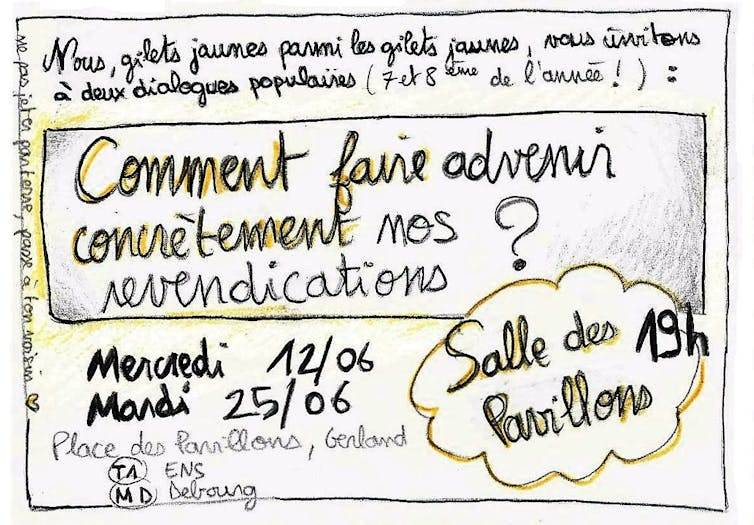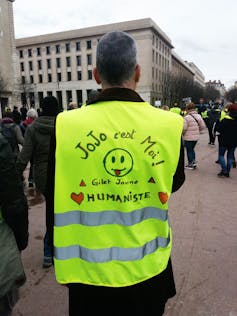
Elise Lobbedez, Author provided
Often perceived as disorganised, scattered and even violent, France’s “gilets jaunes” movement has taken many by surprise with its staying power. A year into the movement, which began on November 17, 2018, many activists are still regularly meeting, organising and protesting, despite the challenges they’ve faced over the past 12 months. In fact, for many French citizens, the yellow vest has become a symbol of civic engagement.
If you don’t visit the roundabouts, if you don’t go to the protests, if you don’t meet people, you don’t know shit, and you think that the gilets jaunes are over, that they have no demands, that they’ve lost their purpose. But we are still demonstrating. Our demands haven’t changed. (Stéphanie)
While fewer people attend yellow-vest demonstrations these days, the movement is still going strong. In my ethnographic study of the movement in the Lyon area, I was able to observe that commitment to the movement often goes beyond protesting, occupying roundabouts and breaching toll-road gates. In fact, participants often report that they haven’t had time for anything else this year.
Over time, the rallies have settled into a certain routine, described by one gilet jaune, Margot, as an “activist’s regimen” in our interview this summer.
Participating in operations, handing out flyers, helping the homeless – these are the activities that make up the daily routine of “yellow activism”. During a meeting at the beginning of the school year, Etienne talked about how the days of action on Saturdays eventually became less intense:
I want us to go back to a 9am to 9pm routine. A 12-hour day, right? We need to show we’re still here.

E. Lobbedez, Author provided
Apart from operations on the ground, the daily lives of yellow vests are organised around discussions and experiments in direct democracy, with weekly meetings, conferences and debates. Between tips on what to read, discovery of the world of activism, and tutorials into banner making, many emphasise that they have never learned as much as they have since they joined the movement.
A year of struggle
Some people are against wearing the yellow vest now … I’m not saying they’re wrong. Because, in the end, we’ve been stigmatised too much… (Julien)
During this year of struggle, wearing the yellow vest has not always been easy. The drop in participation sometimes impaired cohesion and led to internal tensions. Several arguments have plagued assemblies, particularly over the way forward. Should protesters ask for a permit to demonstrate? Would teaming up with other movements help boost actions? What would that entail in practice?
With media coverage from many outlets emphasising protester violence, the yellow vest has taken on another kind of symbolism for people outside of the movement, sometimes hindering its efforts.
In some cases, it even constitutes a deterrent to inter-movement collaboration, as was the case during some climate marches, in particular in early January. Some yellow-vest protesters felt unwelcome, and had the impression that they were simply there to boost numbers rather than out of any solidarity with their demands.

E. Lobbedez, Author provided
Symbolically, many feel stigmatised and must navigate the prejudices of their relatives, and onlookers. Within the collective, the culture of sacrifice encourages participants to go all in for the cause, sometimes setting targets that are difficult to attain, at the expense of their health, family life, friendships, and work. Exhaustion due to overinvestment is common, and it is not unusual for some to take a step back, at least for a while.
Life through a yellow lens
When I see some outrageous news, I have no choice but to send it on, to share it. I’m a yellow vest because I’m outraged. (Thierry)
But distancing oneself from the movement does not mean giving up. The political practices developed through this year of activism remain infused in their daily lives, even for those who have packed away their yellow vest.

E. Lobbedez, Author provided
The vest is, above all, a state of mind. Very often, seemingly commonplace daily activities take a political turn: for Anaïs, it’s going to the market rather than the supermarket; for Michel, it’s creating a parents’ network to help with babysitting; for Frédéric, it’s giving up buying things on Amazon.

E. Lobbedez, Author provided
When it comes to the media, everyone pricks up their ears at the mention of strikes and controversial news stories, as they try to get their news from alternative outlets. Francine, for example, has distanced herself from the movement but stays actively informed via independent news sites. She told me about the new platforms she discovered via the yellow-vest movement: “I listened to all the content on ThinkerView … It fosters the exchange of ideas and opens your mind.”
For her, it’s not just about keeping up to date, but familiarising herself with other points of view, which she believes is essential in her day-to-day encounters and interactions.
The vest: a sign of change
I will never stop being an activist now. It might take different forms … Through politics, maybe, or local organisations. But now hooked. After a year like that, trying to change things, you can’t go back to just mindlessly listening to the news on [main French channel] TF1, thinking, ‘Time will tell’. (Florence)
Many in the movement feel the yellow wave has changed their lives. Some, like Maxime Nicolle, decided to seeking another job, more in line with their values. Marie, who worked in the business tourism market, quit her job to look for work that better fits her ideals.
For Florence, the movement was a wake-up call. Her growing involvement led her to decide to leave her partner. She is still very active in the movement but is now wondering what her engagement will be like in the future. Life without some form of activism has become inconceivable for her. She is not alone: some “yellow vests” have decided to run for office within a party or on a citizen’s ticket.

E. Lobbedez, Author provided
Of course, these changes in lives and habits are personal and cannot describe the entire movement, especially given its multifaceted nature. However, they are a testament to the effect the yellow vest movement has on many individuals.
While it is difficult to foresee the movement’s future, it is clear that the yellow vest has changed lives and will continue to impact the future militancy of many of its participants. It will always be there, ready to be resurrected when the time comes.
Elise Lobbedez’s doctoral thesis is supervised by Professor David Courpasson.
Translated from the French by Alice Heathwood for Fast ForWord.
Elise Lobbedez, PhD student au centre de recherche OCE, EM Lyon
This article is republished from The Conversation under a Creative Commons license. Read the original article.


Be the first to comment